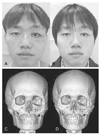The Operation of Facial Bone Fractures
Article information
Abstract
Plastic surgeons who perform reconstructive surgery of facial injuries have a dual responsibility: repair of the aesthetic defect and restoration of the function. The third goal is to minimize the period of disability. although emergent situations are limited in facial injuries, I would like to emphasize the advantages of prompt definitive reconstruction of the injuries and the contribution of early operative intervention to the superior aesthetic and functional outcomes. Socioeconomic and psychological factors make it imperative that an aggressive, expedient, and well-planned surgical program be outlined, operated, and maintained to rehabilitate the patient to return to his or her active and productive life as soon as possible while minimizing aesthetic and functional disabilities. Teaching points: the techniques of extended open reduction and immediate repair or replacement of bone and microvascular tissue transfer of bone or soft tissue have made extensive and challenging injuries manageable. The principle of immediate skeletal stabilization in anatomic position has been enhanced by the use of rigid fixation and the application of craniofacial techniques that is safer and less traumatic for facial bone exposure. In this article, I will present mandibular fracture, orbital wall fracture and maxillar fracture, which are commonly encountered facial bone injuries. We can improve both the functional and aesthetic outcomes of facial fracture treatment when we manage the patients with the current concept of craniofacial techniques based on precise anatomic knowledge.






